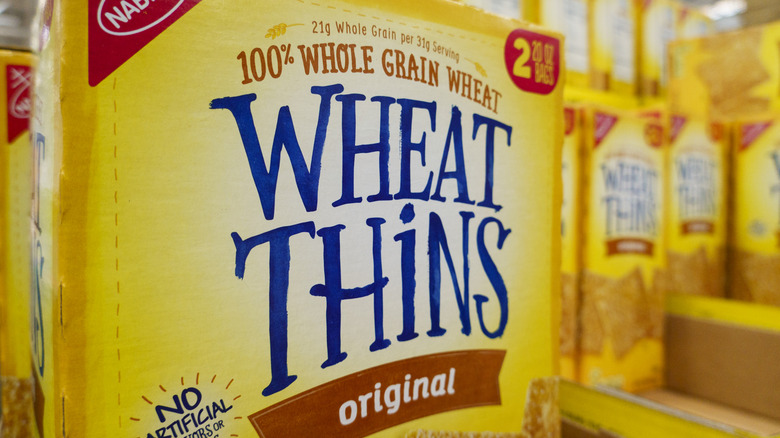This Popular Snack Food Is Banned In Europe But Considered Healthy In The States
When Americans think of healthy snacks, wheat crackers may come to mind — like Wheat Thins. Made mostly from whole grain wheat flour, this snack has 3 grams of fiber in every serving. On that front, Americans need all the help they can get – 95% of people from the United States are not getting enough fiber, according to a 2016 study published in the American Journal of Lifestyle Medicine. Paired with some cheese and an apple, you have a delicious midday snack.
So it's probably surprising to learn that Wheat Thins are banned in Europe because of a questionable ingredient. They are packaged with a little compound called butylated hydroxytoluene (BHT). No, this isn't an article meant to test your knowledge of chemistry. Simply put, BHT is an antioxidant used to help preserve freshness and extend the shelf life of certain packaged foods.
It's banned in Europe because some studies indicated that small animals (like mice and hamsters) that were fed BHT had a higher likelihood of developing certain cancers. It's not 100% clear from various human studies if consuming BHT is safe or unsafe, which is why it's banned in Europe.
How I learned to stop worrying and eat my Wheat Thins
Aside from being the perfect fodder for clickbait articles and weird blogs and watchdog groups, there's actually very little reason to be alarmed by BHT and its cousin butylated hydroxyanisole (BHA), which is also banned in Europe. It's important to understand that Europe operates under a different form of regulating consumer products called the precautionary principle. Basically, if an ingredient is not proven to be safe, or its safety is in doubt, it will be banned, even if it hasn't been proven harmful either. This is why so many American snacks are banned there. It can be summed up as a "better safe than sorry" policy, although in Germany, Cheetos are banned because they're too similar in name to the home-based snack, Chitos. Where are my alarmist articles about that?!
To illustrate, a 1999 study published in the Food and Chemical Toxicology journal found that BHT and BHA consumption in humans showed no signs of actually being carcinogenic. In fact, it reported that these additives may even have anti-carcinogenic properties. A 2000 study from the same journal found similarly inconclusive results.
A lot of the studies aren't even about ingesting BHT, but its use in cosmetics too. Sometimes the studies used to prove how toxic some ingredients are use doses well above what you could ever consume. A lot of these studies are performed on rats, and those results don't always translate to humans. Until further research results in more definitive results, feel free to ignore the alarmist blogs and crunch away on those Wheat Thins — at least in the United States.

